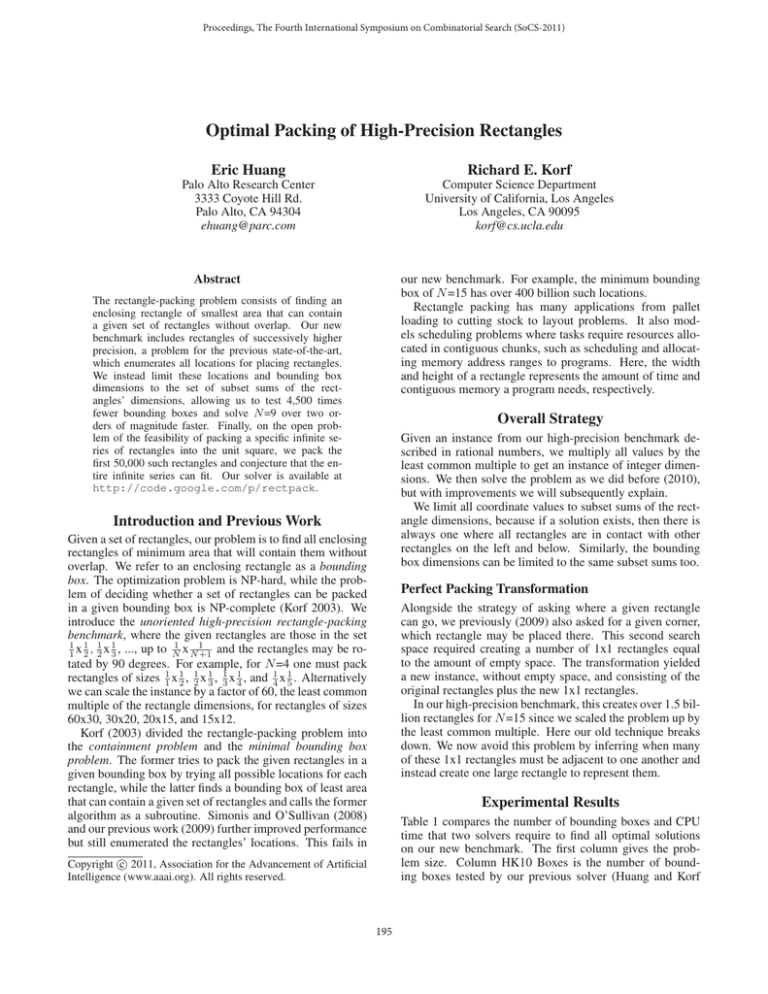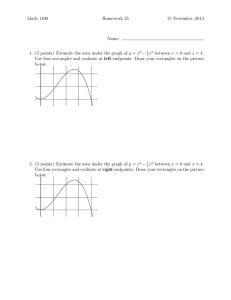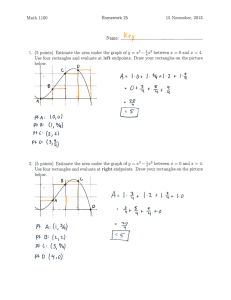
Proceedings, The Fourth International Symposium on Combinatorial Search (SoCS-2011)
Optimal Packing of High-Precision Rectangles
Eric Huang
Richard E. Korf
Palo Alto Research Center
3333 Coyote Hill Rd.
Palo Alto, CA 94304
ehuang@parc.com
Computer Science Department
University of California, Los Angeles
Los Angeles, CA 90095
korf@cs.ucla.edu
our new benchmark. For example, the minimum bounding
box of N =15 has over 400 billion such locations.
Rectangle packing has many applications from pallet
loading to cutting stock to layout problems. It also models scheduling problems where tasks require resources allocated in contiguous chunks, such as scheduling and allocating memory address ranges to programs. Here, the width
and height of a rectangle represents the amount of time and
contiguous memory a program needs, respectively.
Abstract
The rectangle-packing problem consists of finding an
enclosing rectangle of smallest area that can contain
a given set of rectangles without overlap. Our new
benchmark includes rectangles of successively higher
precision, a problem for the previous state-of-the-art,
which enumerates all locations for placing rectangles.
We instead limit these locations and bounding box
dimensions to the set of subset sums of the rectangles’ dimensions, allowing us to test 4,500 times
fewer bounding boxes and solve N =9 over two orders of magnitude faster. Finally, on the open problem of the feasibility of packing a specific infinite series of rectangles into the unit square, we pack the
first 50,000 such rectangles and conjecture that the entire infinite series can fit. Our solver is available at
http://code.google.com/p/rectpack.
Overall Strategy
Given an instance from our high-precision benchmark described in rational numbers, we multiply all values by the
least common multiple to get an instance of integer dimensions. We then solve the problem as we did before (2010),
but with improvements we will subsequently explain.
We limit all coordinate values to subset sums of the rectangle dimensions, because if a solution exists, then there is
always one where all rectangles are in contact with other
rectangles on the left and below. Similarly, the bounding
box dimensions can be limited to the same subset sums too.
Introduction and Previous Work
Given a set of rectangles, our problem is to find all enclosing
rectangles of minimum area that will contain them without
overlap. We refer to an enclosing rectangle as a bounding
box. The optimization problem is NP-hard, while the problem of deciding whether a set of rectangles can be packed
in a given bounding box is NP-complete (Korf 2003). We
introduce the unoriented high-precision rectangle-packing
benchmark, where the given rectangles are those in the set
1 1 1 1
1
1
1 x 2 , 2 x 3 , ..., up to N x N +1 and the rectangles may be rotated by 90 degrees. For example, for N =4 one must pack
rectangles of sizes 11 x 12 , 12 x 13 , 13 x 14 , and 14 x 15 . Alternatively
we can scale the instance by a factor of 60, the least common
multiple of the rectangle dimensions, for rectangles of sizes
60x30, 30x20, 20x15, and 15x12.
Korf (2003) divided the rectangle-packing problem into
the containment problem and the minimal bounding box
problem. The former tries to pack the given rectangles in a
given bounding box by trying all possible locations for each
rectangle, while the latter finds a bounding box of least area
that can contain a given set of rectangles and calls the former
algorithm as a subroutine. Simonis and O’Sullivan (2008)
and our previous work (2009) further improved performance
but still enumerated the rectangles’ locations. This fails in
Perfect Packing Transformation
Alongside the strategy of asking where a given rectangle
can go, we previously (2009) also asked for a given corner,
which rectangle may be placed there. This second search
space required creating a number of 1x1 rectangles equal
to the amount of empty space. The transformation yielded
a new instance, without empty space, and consisting of the
original rectangles plus the new 1x1 rectangles.
In our high-precision benchmark, this creates over 1.5 billion rectangles for N =15 since we scaled the problem up by
the least common multiple. Here our old technique breaks
down. We now avoid this problem by inferring when many
of these 1x1 rectangles must be adjacent to one another and
instead create one large rectangle to represent them.
Experimental Results
Table 1 compares the number of bounding boxes and CPU
time that two solvers require to find all optimal solutions
on our new benchmark. The first column gives the problem size. Column HK10 Boxes is the number of bounding boxes tested by our previous solver (Huang and Korf
c 2011, Association for the Advancement of Artificial
Copyright Intelligence (www.aaai.org). All rights reserved.
195
Size
N
HK10
Boxes
HK11
Boxes
HK10
Time
6
7
8
9
10
11
12
13
14
15
1,979
4,033
39,357
13,571
2,682,948
29
46
124
192
585
1,641
2,366
5,027
9,548
15,334
:00
:02
1:11
1:51
HK11
Time
:00
:00
:00
:00
:01
:18
:33
16:41
46:56
4:28:20
Table 1: Number of bounding boxes tested and CPU time
required to find the minimal bounding boxes containing an
instance of our new benchmark.
2010) when simply scaling up the problem to an integer instance. By comparison, HK11 Boxes corresponds to that
of our new solver, which by N =10 tests 4,500 times fewer
bounding boxes. Here HK10 Boxes ran out of memory on
the last bounding box. The presence of the prime number
11 in the problem instance made N =10 much more difficult
than N =9. Column HK10 Time is the time required by our
old containment solver, using our improved minimal bounding box algorithm. HK11 Time is that of our new solver. By
N =10, HK10 needed to create 6,597,361 1x1 rectangles and
ran out of memory. This data was collected using a Linux
eight core 3GHz Intel Xeon X5460 using one process, one
thread, and one core.
Figure 1: A packing solution for unoriented rectangles of
1
1
x 50,001
in the unit square.
sizes 11 x 12 , 12 x 13 , 13 x 14 , ..., 50,000
of rectangles created during the perfect packing transformation. Our solver is over two orders of magnitude faster at
N =9 than the previous state-of-the-art and tests 4,500 times
fewer bounding boxes. Finally, we report our computational
results on the problem of packing an infinite series of rectangles in the unit square, and conjecture that a packing exists.
Packing an Infinite Series of Rectangles
References
Meir and Moser (1968) asked what was the smallest square
that can contain an infinite series of unoriented rectangles
of sizes 11 x 12 , 12 x 13 , 13 x 14 , ..., etc. The total area of the infinite series equals that of the unit square and it is unknown
whether a feasible packing exists for the series in the unit
square.
Though there has been analytical work on this problem, more recently there have been computational attempts
(Cantrell 2010) that reported packing 10,000 rectangles.
Cantrell’s greedy heuristic placed rectangles in the first feasible bottom-most left-most position (Chazelle 1983), but
his methods were not described in sufficient detail. We use
the same heuristic, and index all placed rectangles with a
four-dimensional kd-tree (Bentley 1975) for overlap testing.
Figure 1 shows the first 50,000 rectangles of the infinite
series. It seems that successive rectangles shrink faster than
they are able to break up the empty space and so we conjecture that packing the infinite series is feasible.
Bentley, J. L. 1975. Multidimensional binary search trees
used for associative searching. Communications of the ACM
18(9):509–517.
Cantrell, D. W. 2010. Personal communication.
Chazelle, B. 1983. The bottomn-left bin-packing heuristic:
An efficient implementation. IEEE Transactions on Computers C-32(8):697–707.
Huang, E., and Korf, R. E. 2009. New improvements in
optimal rectangle packing. In Boutilier, C., ed., IJCAI, 511–
516.
Huang, E., and Korf, R. E. 2010. Optimal rectangle packing
on non-square benchmarks. In AAAI’10: Proceedings of
the 24th National Conference on Artificial intelligence, 317–
324. AAAI Press.
Korf, R. E. 2003. Optimal rectangle packing: Initial results.
In Giunchiglia, E.; Muscettola, N.; and Nau, D. S., eds.,
ICAPS, 287–295. AAAI.
Meir, A., and Moser, L. 1968. On packing of squares and
cubes. Journal of Combinatorial Theory 5(2):126–134.
Simonis, H., and O’Sullivan, B. 2008. Search strategies for
rectangle packing. In Stuckey, P. J., ed., CP, volume 5202
of Lecture Notes in Computer Science, 52–66. Springer.
Conclusion
We have proposed a new benchmark consisting of instances
with rectangles of high-precision dimensions, presented
techniques for using subset sums to limit the number of rectangle positions, and presented ways to reduce the number
196





